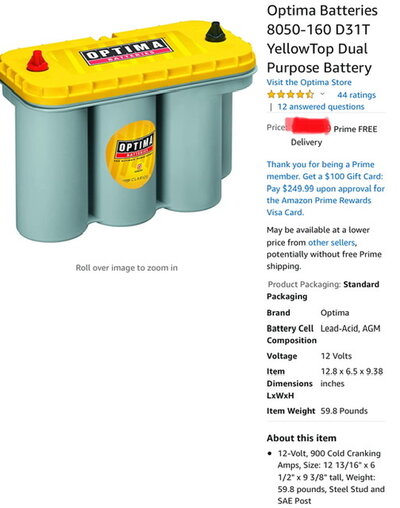80srockandrum
Member
- Joined
- Mar 17, 2019
- Posts
- 24
Looking at possibly switching batteries over from 12v to 6v. Advantages? Disadvantages?
... True DEEP CYCLE battery. about 220 amp hours 110 usable. ...
That is a good question Mike. every time you cycle a battery (run it down and recharge it) it gives up a bit of it's life.What happened to the "unusable" Ah?
Mark B.
Albuquerque, NM
So are the manufacturer data sheets lying (say the T105) when it says they can deliver 700 or so cycles down to 20% SOC? Some batteries spec 10% or even 0% SOC.Now a DEEP CYCLE may recover from occsional OH C!@$! level discharge. (Below 50%)
On this I agree but there are chemical differences and physical differences so that TRUE Deep cycle (As opposed To Marine Deepcycle) Last longer at discharge levels below.. Now the "Minimum state of charge" is a trade off. The deeper the greater the damage.. But for most GC-2's the "Knee" the spot at which the damage increases faster and faster) seems to be about 50%All lead acid batteries are failing from the day they're made, j

Clarification - "damage" is a condition where performance or service life is adversely affected. Using a battery within it's specified range does not damage it because you will realize all of it's rated life. >50%, up to 80% DOD (100% of Ah) in most cases is within the specified range.for most GC-2's the "Knee" the spot at which the damage increases faster and faster) seems to be about 50%
Not in any of the graphs I've seen - it's a gentle parabola curve without any obvious knee. Obviously it varies by battery type and design, but I think the differences are modest. Attached is an example of a depth-of-discharge plot for a deep cycle battery. I've seen other test plots that have steeper curves, but the knee in those is more like at 10% than 50%. That's not a practical limit for RV use.But for most GC-2's the "Knee" the spot at which the damage increases faster and faster) seems to be about 50%
I am new to RVing but from what I have read and listened to the 6V golf car batteries tend to have a few more Amp hours than marine 12V deep cycle. One disadvantage I see in a 2 battery system is that if down the road one fails you have no power.
Correct me if I am wrong but with 2 12V batteries if one fails the other one will give you power1) best advantage of 6V over 12 is the total cost of ownership, 6V deep cycle have higher lifespan, generally more capacity for the size and their cost is attractive vs a similar size 12V.
2) if a single battery fails then yes, you are sol.. in either scenario, any failure will leave you with no power..
Correct me if I am wrong but with 2 12V batteries if one fails the other one will give you power
